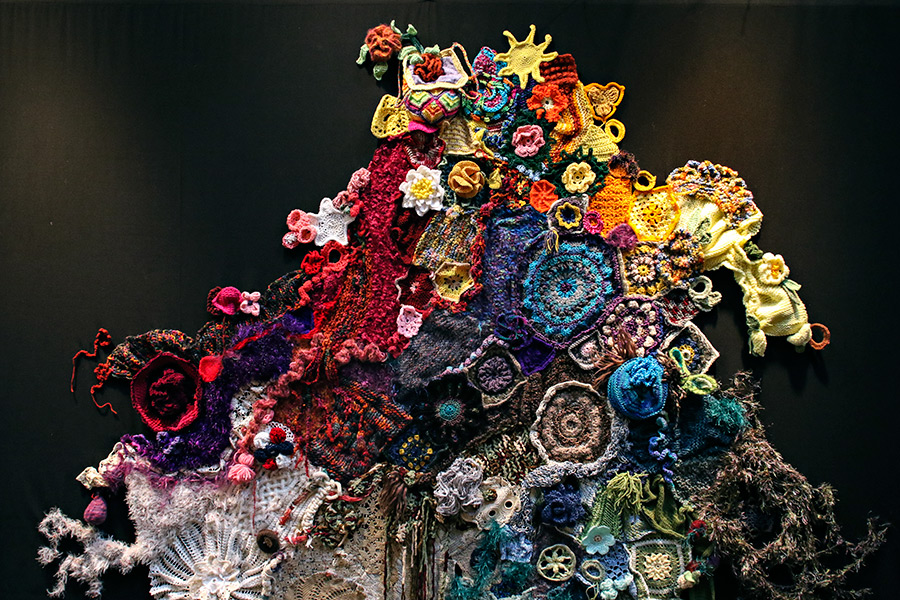The Fabric of Our Lives
Bigfork Art and Cultural Center exhibit showcases fiber and fabric art, along with community-involved project
By Molly Priddy
BIGFORK – When we talk about shared stories and cultures, it’s little coincidence that terms like “societal fabric” or “spin a yarn” come into play.
Ever since humans could harvest the raw materials needed, they have been using yarn and other fabrics to not only keep themselves alive – clothing, ropes, blankets, and baskets are very helpful – but also put their creative mark on the necessities they made.
Blankets became intricate hand-sewn quilts, sheer works of art in their scope and design. Groups of people – typically women, but men in certain cultures also do this work – gathered together for necessary projects, like repairing ripped fishing nets, and in doing so, cemented their communities that much closer.
This is the idea behind the latest exhibit at the Bigfork Art and Cultural Center, “Uncommon Threads: A Celebration of the Fiber Arts.” Such pieces can be found in nearly every culture, interim Executive Director Valerie Homer said, and almost all generations.
“It does resonate on a very emotional level for people,” Homer said.
The exhibit, which opened on Aug. 24 and runs through Sept. 24, includes a variety of fiber and fabric pieces, such as felted animal sculptures, woven tapestries, mixed-media pieces on fabrics, and, of course, a new addition to the center lovingly called the Woolly Garden.
The Woolly Garden is a dynamic, community art project made of crocheted or knitted pieces all attached together and presented as one. Anyone can contribute a piece, Homer said, whether they make it during one of the center’s Thursday knitting and crocheting sessions or at home.
A tourist from out of state wandered into the exhibit, saw the Garden, and crocheted a piece quickly before she walked back out and left, Homer said, while other contributions have come from people as far away as New Jersey and Oklahoma. The county’s libraries have also held events with fabrics to support the installation, Homer said, so contributions have been flowing in from around the valley as well.
“It’s made with many hands, many lives, and many hearts,” Homer said.
Leading the project are artists Jill Gotschalk, Sue Hanson, Robin Magaddino, and Betty Violette. Homer said the initial Woolly Garden is small on purpose, because it will receive additions as the month goes on.
The Thursday crocheting and knitting sessions, which take place at noon and are free, offer lessons on how to do both crafts, while attendees make connections among themselves. Homer said conversations in the early sessions often turned to family fabric treasures, so the center designated the upstairs section as the Heirloom Room to showcase some of those precious possessions. An assembled book provides a guide to the stories behind each piece.
“I have a crocheted blanket up there that my grandma made,” Homer said.
Those groups, having met several times to spin yarns over spun yarn, are now their own little community, Homer said, and meet up with one another outside of the project. That’s a big piece of Uncommon Threads, she said. By getting more people involved with it, BACC has removed one of the biggest roadblocks in the way of higher visitation numbers: the intimidation factor.
Most museums divide fine art from craft, which Homer believes is a mistake, given that most crafts take as much or more talent as the fine arts do. By classifying it all as art, BACC opens up the experience to a new audience.
“It truly builds community,” Homer said. “There’s a community now that’s really proud of this piece.”
The Woolly Garden will be on display at BACC until the exhibit closes, and after that, Homer hopes to give it a life on the road, to be displayed in other cities and serve as inspiration for other community art projects.
So far, many of those who have participated have stopped by with family and friends to show off their work in a museum setting. It’s a sign that BACC is beginning to achieve its goal of diversifying its exhibit lineup to involve more of the community, and it will most likely grow with the Woolly Garden itself.
“The piece will evolve,” Homer said.
For more information, call 406-837-6927. The Bigfork Art and Cultural Center is located at 525 Electric Ave., Bigfork.